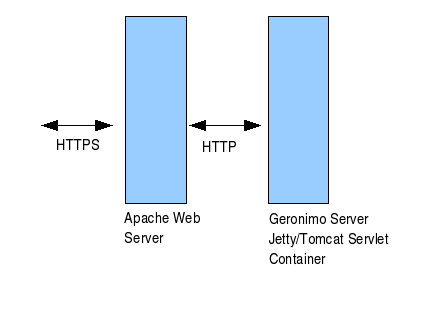

|
| Home > Documentation > Reference > Geronimo Architecture > Topology planning |
In today's globalized world, modern organizations face a lot of opportunities and challenges every day. Many of these challenges can put an onus on the organization's IT infrastructure therefore its configuration is crucial. The Apache Geronimo application server supports small-to-medium-sized enterprise applications and provides robust, secure support for the latest Java EE specification. This section will highlight the different configuration options that can be used in your production environment.
The figure below illustrates a client machine accessing an application hosted in the Geronimo server. Although the figure depicts only one client machine, several machines can be connected to the server and users on these machines can access the hosted Web applications using a standard Web browser.
The client-side application may vary ranging from being a simple command line user interface to a full-fledged user interface such as those created using popular client-side GUI technology. These applications can access the Web tier by connecting to the server using their own HTTP connections, or they can access business and EIS tier objects through the help of the Geronimo client application container.
Features of the Geronimo application client:

Three tier architecture system is more scalable than two tier as it supports hundreds of users and organizations. It also increases flexibility and freedom.

The Apache Web server is the best, and most popular, HTTP server software in use on the Internet today. In your production environment using Geronimo with the Apache Web server would give you some rigorous advantages as given below.



|
|
Privacy Policy - Copyright © 2003-2011, The Apache Software Foundation, Licensed under ASL 2.0. |